Stakeholder Management Processes in Projects
Abstract
A Stakeholder Manager is an essential element for a prosperous project, program or portfolio. A stakeholder is an individual who will or can be affected by the aforementioned aspects. Thus, stakeholder management considers how the relationship between stakeholders can be affected and what processes can mitigate altercations. Stakeholder management processes are fundamental through businesses, organisations and projects, a set of strategies were developed to analyse stakeholders. The goals for the stakeholder management processes are to:
- Maximise supportive stakeholder engagement in projects
- Ensure the processes are understood by all stakeholders
- Introduce multiple key principles and processes for different stakeholder situations
This article looks into how essential separate stakeholder processes are for projects. Powerful stakeholders can be used in early development of projects or portfolios to improve quality. “The ability of the project manager to correctly identify and manage these stakeholders in an appropriate manner can mean the difference between success and failure”. [1] But, this can only begin once resources and a general understanding of the problem is gained through multiple meetings. Thus anticipation and prediction allows the Stakeholder Manager to plan and support their actions. This article focusses on the stakeholder analysis via Stakeholder Management Processes. Therefore 4 processes are mentioned within this article: Power/Interested Grid, Stakeholder Interest and Impact Table, Salience Model and Organisational Political Map Technique. Nevertheless, topics such as engagement, key principles and effective teamwork regarding Stakeholder Management are mentioned for a clear understanding of the entire process. Improvements of Stakeholder Management Processes are specified for clarification throughout this article. This can only start through Stakeholder Identification processes.
Contents |
Stakeholder Identification
Before the management can begin with multiple processes within a project, an identification is essential. The identification includes an initial brainstorm investigating all stakeholders who are potentially affected by any decision throughout the project. Stakeholders can be businesses, companies, individuals or educational industries; therefore, spending a sufficient amount of time on the identification process is fundamental. The following questions should be asked during the brainstorming session to embark on the identification process [2]:
- Who is the suppler of the project?
- Who is the customer?
- Who influences the main stakeholders?
- Who can be affected by the project?
- Who is working towards solving the project?
- Who has the decisions over resources?
- Who is ultimately in charge of the success of the project?
Once these questions have been answered, the stakeholders can be classified and analysed.
The image shows how multiple stakeholders are sprung from a simple beginning. The identification process is the basis for any Stakeholder Manager in the beginning of a project, program or portfolio. Therefore, this process should be conducted with known stakeholders before an analysis process can begin. Thereafter, the analysis of individual stakeholders can commence.
Stakeholder Analysis
Once the identification process is clear and all stakeholders are found and named, the stakeholder analysis can begin. The analysis looks at an in depth classification of individuals in order to find the most relevant for certain situations. This is conducted to aid the Stakeholder Manager within the project in scenarios such as:
- Disruptions of the project due to a stakeholder
- Key stakeholders to inform about critical decisions
- Communication method
- Reducing negative impacts of certain stakeholders
- Timeline for completion of events
- Resources needed from stakeholders
Managing these and engaging key stakeholders is a tool that creates a successful project. The stakeholders can be analysed using a variety of processes. Three of which are shown here.
Power/Interested Grid
One method is the Power/Interested Grid. By classifying each stakeholder by power over work or interest over work.
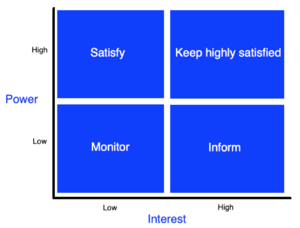
- High power, interested people: Stakeholders who hold the most power over a project and you must make the largest effort to satisfy. These Stakeholders are extremely important as they are engaged within the project but also have the influence to close down or input with more resources. Hence, keep these stakeholders as satisfied as possible.
- High power, less interested people: Stakeholders who hold the most power but are not that engaged within the project. Equally as important as the prior stakeholder in regards to power but these are not highly interested within the project at hand. You should keep these satisfied but weekly meetings and messages are more relaxed.
- Low power, interested people: Stakeholders who do not have the power over the project but are highly keen on the outcome or issues that may arise. The Stakeholders who are interested but low in power may aid the project in multiple ways as they will be involved. Important to note that these stakeholders are often from outside businesses and although resources might be limited to begin with, investments are frequent as projects come to completion.
- Low power, less interested people: Stakeholders with little power and are no interested with the project at hand. These Stakeholders are the least important but they should still be monitored and analysed for future reference incase they move into a different position.
The managers can now be placed onto the Power/Interest Table. It is important that all stakeholders are placed. The higher the stakeholder is to the top right, the more influential the stakeholder can be. Once all stakeholders are placed onto the table, the engagement process can begin. Or, if this process was not suitable for your stakeholders then look into the two following processes.
Stakeholder Interest and Impact Table
A second process for stakeholder analysis is to use a Stakeholder Interest and Impact Table. The table takes all the stakeholder identified in step one, lists them on the left hand-side of the table then remarks all interests of said stakeholder. Once all interests are listed, a project impact rated from low-high with a + or - is given. The impact noted gives an integer priority number from 1 - n, with 1 being the most influential stakeholder. From the analysis section, stakeholders need to stay engaged. The following section explains how to engage all stakeholders and how influential the commitment of stakeholders outlines a project.
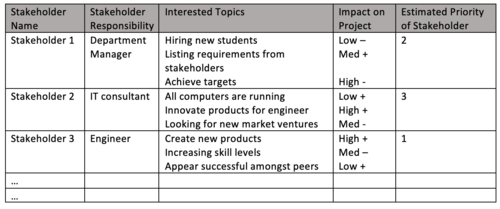
The table gives an overview of which stakeholder has the highest priority based on their interests and how that impacts the project. If the estimated project impact for all the interests are high then the priority should also be high and visa versa.
Salience Model
The Salience Model looks at the The degree to which managers give priority to the competing stakeholder claims. [3] The priority of analysis is based on 3 factors; Power, Legitimacy and Urgency. Power is a social factor where Stakeholder A can force Stakeholder B to do something that they would not have otherwise done. Legitimacy is how appropriate a stakeholders desires and actions are based on social norms, beliefs and definitions. Urgency is how fast the stakeholder acts upon an immediate decision or action. If the stakeholder is one out of three of the factors, this is known as a latent stakeholder, making them low on the salience scale. If they have 2 attributes, the stakeholders are known as expectant. These are medium on the salience scale. If the stakeholder has power, legitimacy and urgency they are a definitive stakeholder with the highest salience. The Venn Diagram below represents the Salience Model.
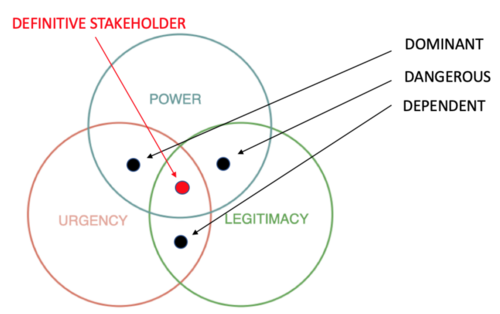
Once the stakeholders are all defined via a Salience Model, the definitive stakeholders should have the highest priority. The next stakeholder depends on the project at hand but one of the expectant stakeholders should follow. Finally, the latent stakeholders should be last on the list of importance according to the Salience Model. If a stakeholder does not fit onto the model then they are not relevant for the project.
Organisational Political Map Technique
The final analysis which can be used is the Organisational Political Map Technique. It involves analysing who can affect a decision and where they stand within the company. Begin with the identification phase, followed by your overview milestones of the project. Once the milestones are found, stakeholders should be placed into which milestone they influence. Not only for the final decision of the milestone but also for those who influence in a smaller manor. Then 4 steps should be followed:
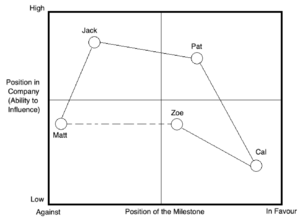
1) Rank the stakeholders by their position in the company. Anyone who has a final say in the decision or puts highly sort after resources into the project should be very high.
2) Rank their ability to influence all decisions within the milestones.
3) Graph these two factors against each other (Influence vs Position) to illustrate which stakeholders have the largest stake in the project.
4) Map the relationship of all stakeholders. Any relationships which are neutral should not be noted; only strong positive (solid line) and strong negative (dashed line).
The diagram shows that if Cal wants a milestone accepted then he should ask Pat and Jack. Whereas Zoe and Matt have a negative relationship so should not work together unless necessary. This tool is powerful tool for understanding the politics behind the company. If a decision is made within that milestone of the project, who is in control of the influence and who is high up in the company and can change this decision. Stakeholder Managers should use this tool in companies which they often do not know well or they want to understand better. Consultants should use this to enable and develop strategies for interacting with all stakeholders and ensuring a desired result is reached.
Stakeholder Engagement
According to the European Bank for Reconstruction and Development, Environmental and Social Policy, Stakeholder Engagement is a free manipulation, interference, coercion, and intimidation, and conducted on the basis of timely, relevant, understandable and accessible information, in a culturally appropriate format [4] By engaging correctly with all stakeholders in an appropriate matter, it can cut costs, enhance reputation, avoid conflicts, identify risks, manage expectations and improve cooperative policies. In order to engage all stakeholders in the project, the Stakeholder Manager must remember four aspects:
Time and Resources are Precious - To engage with all stakeholders, it takes time to develop trust relationships. They should not be pushed onto stakeholders but rather nurtured and fostered. Remember that engaging with stakeholders takes resources such as labour and capital so be concise.
High Expectations - Stakeholders will start a project with unrealistic high expectations of benefits that may occur. This is known as a blind path. To avoid this, the Stakeholder Manager must engage and outset the project in a clear and mannered way.
Participation from Stakeholders - Diversity norms can bring stakeholders closer or drive them further apart. Often conflicts arise due to a conflicting cultural community that can jeopardise a project and lead to stakeholders avoiding participation in projects. The Stakeholder Manager must address these issues prior to the project beginning if possible. Often if the project does not engage within a stakeholders life, lack of participation will also occur. To avoid this case, interact and challenge stakeholders opinions with feedback from cliental and consultants. Thus, they will feel more involved and participation will increase.
From the engagement process, seven key principles should be focused on for a Stakeholder Management within a project.
Stakeholder Management Key Principle Processes
The key principles for Stakeholder Managers to keep in mind throughout a project. Whilst making all decisions, this should be the first port of call before taking the risk. There are seven processes that aid a Stakeholder Manager within a project scenario.
1. Early consultation and multiple meetings - A project during early stages is difficult to define to all stakeholders. A meeting regarding all high power and high interested stakeholders (REFERENCE BACK TO PREVIOUS PAGE) should be initiated within the first few weeks of defining the project. The meetings should include a timeline, preliminary budget and main stakeholders with their requirements. This enables a negotiation and initial communication.
2. Communication - Mentioned multiple times within this article, communicate, communicate, communicate. Before trying to influence and relying on stakeholders, gathering, sharing and communicating information is important. A communication platform should be established and focused on within the initiation of the project.
3. Responsibility - As a Stakeholder Manager, it is your role to engage all relevant stakeholders and for you to govern the success. A good Stakeholder Manager takes responsibility for all stakeholders regardless of their status.
4. Success Criteria - A successful project can be defined in infinite ways if different perspectives are asked. Whilst developing the project outline, define what success is meant to the Stakeholder Manager and establish a baseline of success. Once the project is finished, this should be reviewed.
5. Compromise - During initiation, stakeholders often have diverging opinions. A compromise is often swiftly met but if this is not the case then the responsibility lays on the Stakeholder Manager. A weighted hierarchy via a voting system is common but the argument must fulfil the requirements of all stakeholders first.
6. Managing Risk - Starting any project is a risk of some kind. Whether this includes a resource, monetary or time risk. But every risk is an opportunity is correctly endeavored and used, accolades are rewarded. A Stakeholder Manager should at every step of this process, look into what is the largest risk and how can this be mitigated.
7. Plan it, plan it, plan it - There is never too much planning involved for a Stakeholder Manager. For each step, take a measured and conscientious approach to plan. Spend more of your time planning and discussing then you can bring significant benefits to the highest and most interest stakeholders.
Stakeholder Effective Teamwork
As a Stakeholder Manager, working efficiently and effectively on projects is fundamental. The manager is responsible not only for the outcome but for satisfying all relevant parties affected by the process and fallout. According to McIntyre & Salas [5], there are 5 principles of effective teamwork.
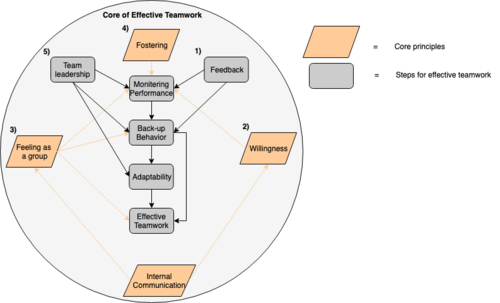
1. FEEDBACK to and from one another
2. WILLINGNESS to and from fellow stakeholders
3. FEELING AS A GROUP whose success depends on interaction
4. FOSTERING within-team interdependence
5. TEAM LEADERSHIP affects performance of the team.
The principles aforementioned according to McIntyre & Salas ensure a successful project being ran by a Stakeholder Manager. The feedback establishes a flat organisational structure in regards to communication. This asset declares everyones voice to be heard. The willingness to and from stakeholders
Managing the effective teamwork runs through the heart of all processes in projects. Making sure that the individuals within the project work together cooperatively has three known benefits:
1) Quick and easy problem solving: The first benefit is overcoming plausible problems quick and easily. Once communication, coordination and bonding is established, ideas are constructed and effortlessly announced. Accordingly, solutions are found for problems briskly.
2) Strong staff relationships: Another benefit with effective teammate is a strong relationship between all staff members. A Stakeholder Manager aims at bringing all stakeholders together from juxtaposing areas of the business. Their experiences, knowledge and skills from previous projects can be shared to gain an advantage over competition.
3) Healthy competition: Competition is crucial. Ensuring an indispensable amount of knowledge is gained but it must not detriment a stakeholders reputation. For this, healthy competition is used. Within an organisation, the project or company vision should come first. This means that there should be a constant state of improvement via meetings, self-awareness and motivation incentives. Remember that healthy competition drives a successful project but unhealthy competition breaks a project down.
Summary
Stakeholder Managers are an essential element for ensuring a smooth and successful project. This article looked at several processes in a step-by-step guide on how a Stakeholder Manager can identify, analyse, engage and use effective teamwork to get the best work out of all interested stakeholders. This article goes into depth within the Stakeholder Analysis section with 4 processes that Stakeholder Managers should consider to prioritise the most influential stakeholders. If the Stakeholder Manager wants to go into depth in any topic, it is covered within the Project Management Institute [1].
Annotated Bibliography
[1] The Project Management Institute (PMI) book looks into how identification and planning for the management of stakeholders aids a project. This is the book covering all standards for project management so topics such as project risk management, project human resource management and control management. Many helpful examples and illustrations.
[3] The article is an easy read for Project Managers and Stakeholder Identification. It goes into great detail covering all topics regarding the marketing and selling of products and how stakeholders should interact with each other.
[7] A short but concise book outlining the implications of situation awareness in Stakeholder Management Processes. The topics identify characteristics of team situation awareness and research questions are outlined that target the measurement of engaging stakeholders
Annotated Figures
This section is aimed at aiding readers to where the images were originally created. All images have been inspired by articles or books but they have ALL been created by Jack Frain.
[Figure 1] Inspired by Stakeholder Identification and Analysis Made Easy for Project Managers article but the image was created by Jack Frain.
[Figure 2] Inspired by the PMI book but the image was created by Jack Frain.
[Figure 3] Inspired by the PMI book but the image was created by Jack Frain.
[Figure 4] Inspired by PMI BIG FIVE IN TEAMWORK p571 but the image was created by Jack Frain.
[Figure 5] Inspired by the PMI book but the image was created by Jack Frain.
[Figure 6] Inspired by the PMI book but the image was created by Jack Frain.
References
- ↑ 1.0 1.1 1.2 1.3 1.4 1.5 Project Management Institute, A Guide to the Project Management Body of Knowledge (PMBOK® Guide), Fifth Edition, 2013
- ↑ Smith, L. W. (2000). Stakeholder analysis: a pivotal practice of successful projects. Paper presented at Project Management Institute Annual Seminars & Symposium, Houston, TX. Newtown Square, PA: Project Management Institute.
- ↑ 3.0 3.1 Ronald K. Mitchell, Bradley R. Agle, Donna J. Wood. The Academy of Management Review, Vol. 22, No. 4, 1997, p872
- ↑ The European Bank for Reconstruction and Development, Environmental and social Policy, may 2014: Performance Requirement 10 para.5., 2014
- ↑ Muchinsky, McIntyre & Salas, Situation Awareness in Team Performance: Implications for Measurement and Training, Third Edition, 2006